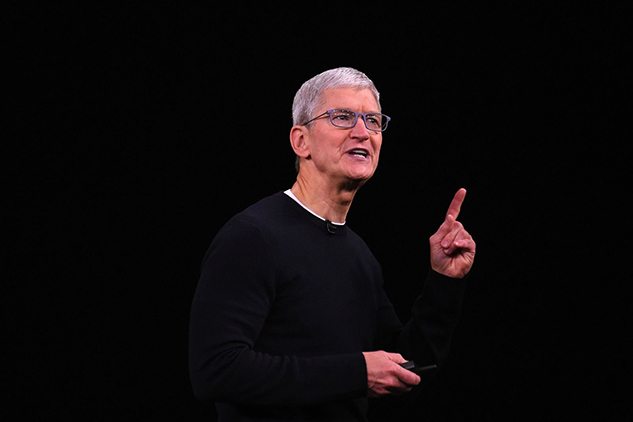Cook Streamlines Apple Supply Chain, Trims Case Supplier Profits

Source:Getty Images
Once upon a time, Apple spent vast amounts of money helping OEM suppliers purchase manufacturing equipment. However, as Apple chief Tim Cook’s cost controls have become increasingly strict, the rules of the game have evolved with new developments. And a set of critical figures signifies that Apple has already initiated a brutal pricing war.
Views
Cook Streamlines Apple Supply Chain, Trims Case Supplier Profits
By Elaine HuangFrom CommonWealth Magazine (vol. 702 )
“Doing business with Apple is like doing crack; it’s a hard habit to quit,” laments an executive at an Apple supplier.
This is especially true of iPhone orders, which carry the sheer volume of tens of millions of shipped units and tantalizing profits. Suppliers that make it onto the vendor list find themselves intoxicated by the rush one can get from the surging stock prices and sales performance.
If that rush suddenly comes to a grinding halt, it can cause severe withdrawal symptoms. This is exemplified by Apple’s case suppliers, who are currently going through the late-stage Apple addiction phase.
This discussion can begin with some numbers in Apple’s annual report for the 2019 fiscal year that very few people have likely noticed.
Shockingly, Apple’s capital expenditures of US$7.6 billion for the 2019 fiscal year were less than half of that of the previous year’s US$16.7 billion.
What does capital expenditures being slashed in half mean?
“This means that Apple isn’t spending (to help purchase equipment) anymore,” says an executive at an Apple case vendor.
Horace Dediu, a renowned U.S.-based Apple analyst, observes that Apple’s massive annual capital expenditure - enough to buy two aircraft carriers - is largely spent in two areas: data center purchases and production equipment and facilities, of which the latter occupies the bulk. For example, a CNC cutting machine used in the manufacturing of metal iPhone and iPad cases costs upwards of US$1 million.
“That’s a specialized machine only for use in making Apple products,” attests the Apple case vendor executive. In the past, up to 80 percent of the equipment used by Apple’s case suppliers, from Honhai subsidiary Foxconn Precision to U.S.-based Jabil, and Catcher Technology, belonged to Apple.
However, iPhone growth has reached a plateau, thereby greatly reducing pressure on case vendors to step up production capacity every year. Secondly, Apple chief executive Tim Cook’s stance towards suppliers has become increasingly severe.
Supply chain faces reality of obsolescence
“They’ve (Apple) gotten very cutthroat; that’s their attitude now, that you should put up the money. And if you don’t want to, someone else will,” one electronics OEM executive said candidly.
Casetek, a Pegatron subsidiary, was the first victim, reaching deep into its own pockets to come up with NT$18 billion to purchase 6,000 machines, only for no iPhone orders to materialize. Since then, the company has incurred losses for two consecutive years.
Catcher Technology, the best-known Apple case OEM manufacturer, was the second victim.
Catcher recorded revenue of NT$91.6 billion in 2019, for net after tax profit of NT$11.27 billion, which was sixty percent less than the previous year.
In 2018 Catcher’s capital outlay was NT$11 billion, the vast majority of which went towards plant expansions and purchasing equipment for the iPhone XR model, in which Apple placed great expectations.
According to data from research agency Omdia, a subsidiary of IHS Markit, this mid-level smartphone took the honors as the best-selling smartphone in the world in 2019, with sales of 46 million units.
 (Source: Shutterstock)
(Source: Shutterstock)
So why did Catcher suffer a dramatic drop in profits despite betting on the right smartphone model?
It turns out that the initial market response to the introduction of the iPhone XR in 2018 was below expectations. Consequently, Catcher’s inventory from 4Q 2018 through 1Q 2019 was worth NT$25.2 and $24 billion, respectively.
Apple introduced heavily discounted prices in early 2019, slashing prices on the iPhone XR by 15 percent in its main China market. The strategy paid off, as Apple sales rapidly warmed back up.
However, hidden behind the rare iPhone sales event was an unprecedented time of shared difficulty for suppliers.
‘Nurture, seize, kill’ approach enters final stage
Apple asked Catcher, laden with inventory, to reduce prices at the tail end of the iPhone XR’s run, at the same time slashing prices on cases for the new iPhone 11.
During a late June shareholder meeting, Catcher chairman Allen Horng spoke candidly, saying “the major smartphone brands aren’t growing, and are even declining. In this environment, the client will exercise strict control of expenditures, putting considerable pressure on the supply chain. This can explain why last year was unprofitable for us.”
Asked if the client had demanded reduced prices, Horng responded, “Simply stated, that is what happened.”
For case manufacturers, Apple’s “nurture, seize, kill” strategy towards suppliers has entered the final stage.
As Apple sales have stagnated, case manufacturers see supply outstripping demand. And apart from the big three groups of Foxconn, Jabil, Catcher, Casetek, and PRC-based Luxshare Precision and Lens Technology are eager to step up.
“Everyone knows the rules of the game. To be honest, it’s really tough going right now,” laments one executive at a supplier.
Have you read?
♦ Largan: the Supplier Apple Can’t Shake
♦ Taiwan’s Top 50 Performers: IC Design Leads the Pack Thanks to China’s 5G Potential
♦ Taiwan Top 50 Business Groups: 20 Years Later, Who’s In and Who’s Out?
Translated by David Toman
Edited by TC Lin
Uploaded by Judy Lu






